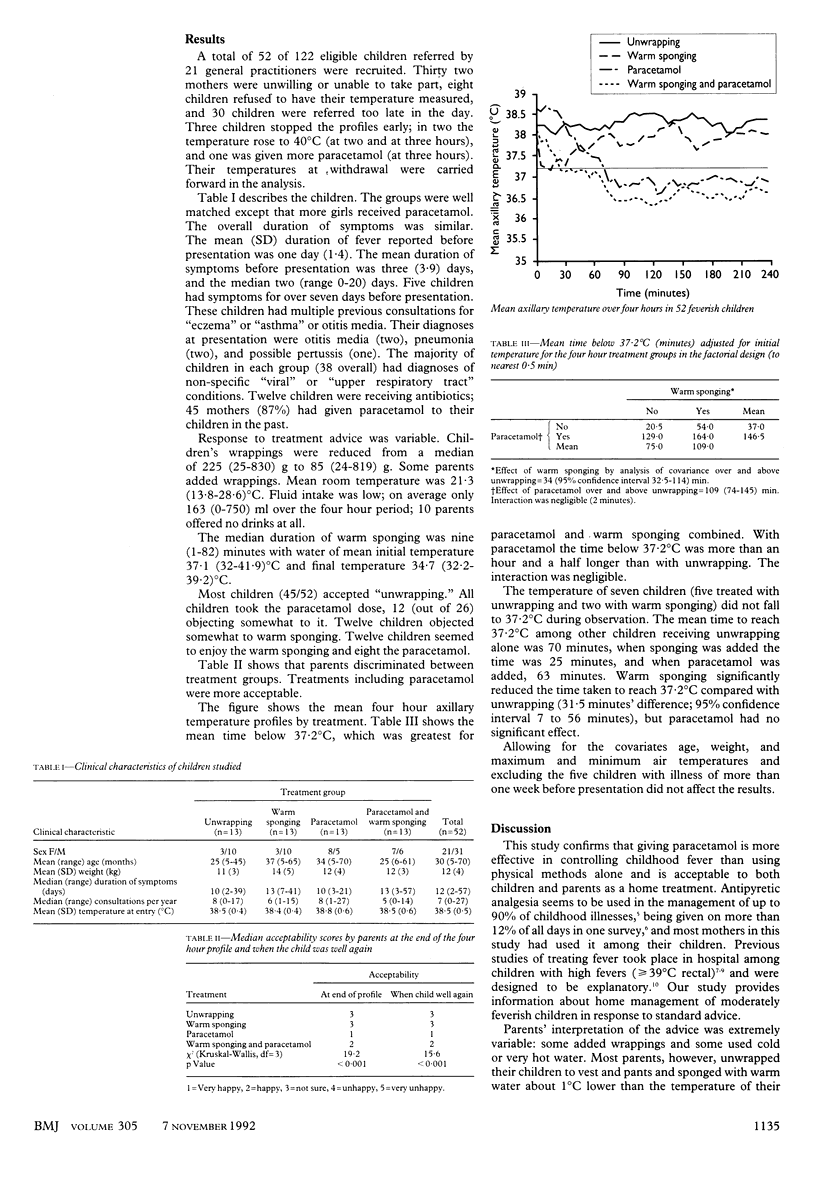Abstract
OBJECTIVES--To compare the acceptability and effects on temperature of advice to unwrap children and give paracetamol or warm sponging treatments in the management of feverish illness at home. DESIGN--A randomised, open, parallel group study using factorial design comparison of unwrapping, warm sponging plus unwrapping, paracetamol plus unwrapping, and paracetamol and warm sponging plus unwrapping. SETTING--Homes of willing families with a feverish child recruited after consulting one of 21 participating general practitioners in Southampton. SUBJECTS--52 children aged from 3 months to 5 years with axillary temperatures before treatment of > or = 37.8 degrees C and < 40 degrees C. MAIN OUTCOME MEASURES--Response to advice assessed over four hours; temperature assessed by continuous data logging from an axillary thermistor; acceptability of treatment to child and parent scored on Likert scales immediately after treatment and on return to health. RESULTS--Response to treatment advice varied; unwrapping alone had little effect on temperature. Paracetamol increased the time below 37.2 degrees C in four hours by 109 (95% confidence interval 74 to 145) minutes compared with unwrapping; warm sponging caused the fastest reduction in temperature. Parents discriminated between treatments, preferring paracetamol. CONCLUSION--Advice to give paracetamol is more effective than sponging or unwrapping in controlling temperature in children at home and is more acceptable to parents. Warm sponging has an additive effect and reduces fever more quickly than paracetamol.
Full text
PDF


Selected References
These references are in PubMed. This may not be the complete list of references from this article.
- Hunter J. Study of antipyretic therapy in current use. Arch Dis Child. 1973 Apr;48(4):313–315. doi: 10.1136/adc.48.4.313. [DOI] [PMC free article] [PubMed] [Google Scholar]
- Kluger M. J. Fever. Pediatrics. 1980 Nov;66(5):720–724. [PubMed] [Google Scholar]
- Kramer M. S., Naimark L. E., Roberts-Bräuer R., McDougall A., Leduc D. G. Risks and benefits of paracetamol antipyresis in young children with fever of presumed viral origin. Lancet. 1991 Mar 9;337(8741):591–594. doi: 10.1016/0140-6736(91)91648-e. [DOI] [PubMed] [Google Scholar]
- Matthews J. N., Altman D. G., Campbell M. J., Royston P. Analysis of serial measurements in medical research. BMJ. 1990 Jan 27;300(6719):230–235. doi: 10.1136/bmj.300.6719.230. [DOI] [PMC free article] [PubMed] [Google Scholar]
- Newman J. Evaluation of sponging to reduce body temperature in febrile children. Can Med Assoc J. 1985 Mar 15;132(6):641–642. [PMC free article] [PubMed] [Google Scholar]
- Pantell R. H., Naber M., Lamar R., Dias J. K. Fever in the first six months of life: risks of underlying serious infection. Clin Pediatr (Phila) 1980 Feb;19(2):77–82. doi: 10.1177/000992288001900201. [DOI] [PubMed] [Google Scholar]
- Rylance G. W., Woods C. G., Cullen R. E., Rylance M. E. Use of drugs by children. BMJ. 1988 Aug 13;297(6646):445–447. doi: 10.1136/bmj.297.6646.445. [DOI] [PMC free article] [PubMed] [Google Scholar]
- Schwartz D., Lellouch J. Explanatory and pragmatic attitudes in therapeutical trials. J Chronic Dis. 1967 Aug;20(8):637–648. doi: 10.1016/0021-9681(67)90041-0. [DOI] [PubMed] [Google Scholar]
- Steele R. W., Tanaka P. T., Lara R. P., Bass J. W. Evaluation of sponging and of oral antipyretic therapy to reduce fever. J Pediatr. 1970 Nov;77(5):824–829. doi: 10.1016/s0022-3476(70)80242-6. [DOI] [PubMed] [Google Scholar]
- Taylor J. P., Gustafson T. L., Johnson C. C., Brandenburg N., Glezen W. P. Antipyretic use among children during the 1983 influenza season. Am J Dis Child. 1985 May;139(5):486–488. doi: 10.1001/archpedi.1985.02140070060034. [DOI] [PubMed] [Google Scholar]


